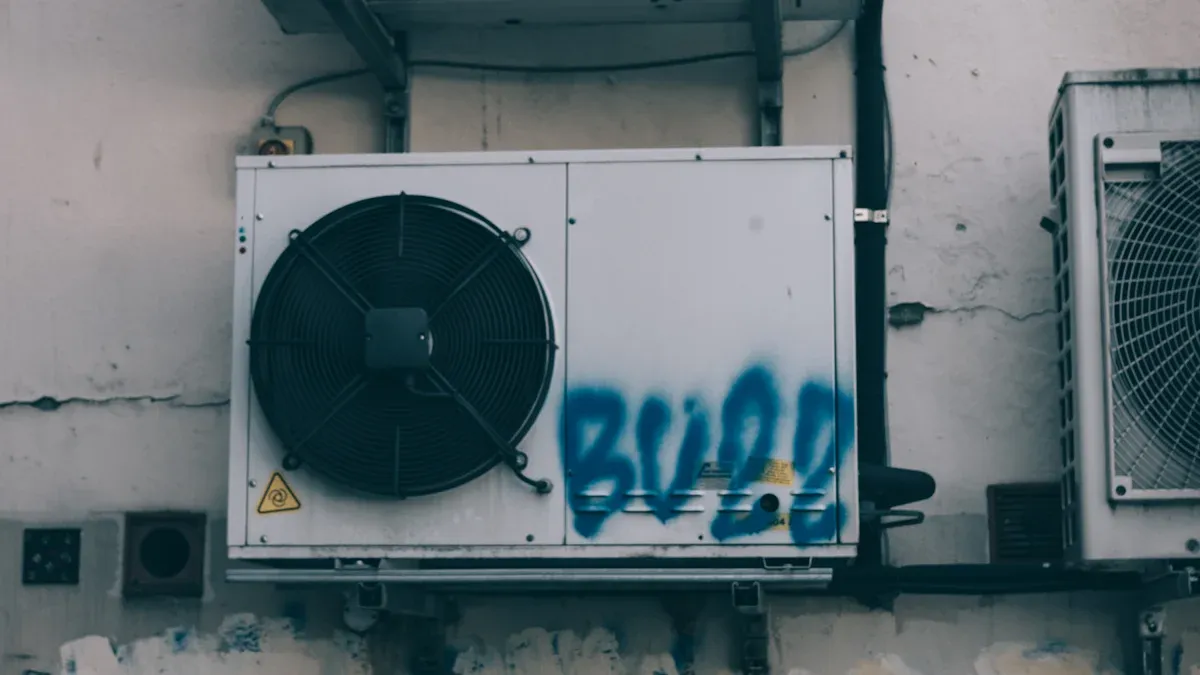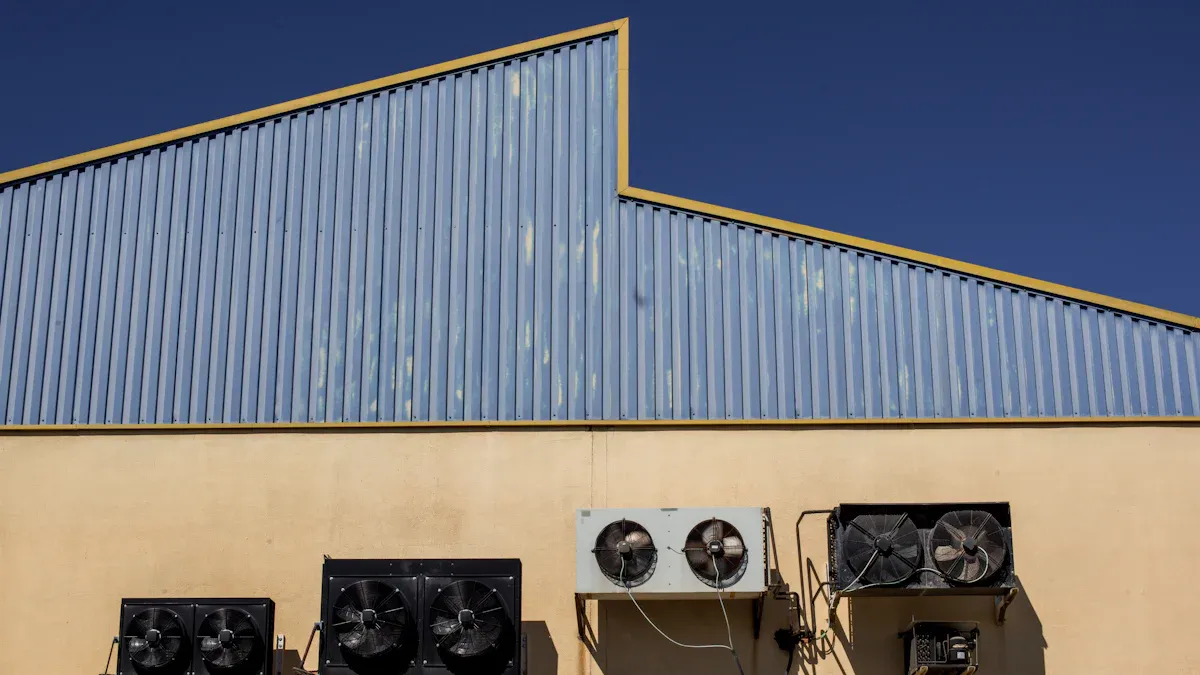Author:
-
Position:
General Manager of Foreign Trade Department, Taojun Refrigeration -
Professional Experience:
Engaged in international trade within the refrigeration industry since 2004.
Expert in brand strategy and omni-channel marketing, having led three multi-million yuan projects that boosted brand exposure by over 200%.
-
Core Competencies:
Proficient in data analysis and user growth strategies.
Skilled in SEO/SEM and social media management tools.
Experienced in cross-departmental collaboration and team leadership.
-
Philosophy:
"Data-driven decisions, creativity-powered branding." Committed to achieving business value and user experience excellence through refined operations. -
Vision:
Eager to collaborate with partners to explore emerging market opportunities and set industry benchmark cases.
Contact Us to Find More Products
Optimizing Refrigeration System Performance with Proper Condenser Sizing

Proper condenser sizing forms the backbone of effective refrigeration system optimization. When engineers select the right condenser size, they ensure the system operates at peak efficiency. The correct match reduces unnecessary energy use and helps avoid costly breakdowns. Oversized or undersized condensers can lead to increased wear, higher operating costs, and shorter equipment life. System designers who prioritize accurate sizing protect both performance and long-term reliability.
Key Takeaways
- Choosing the right condenser size improves refrigeration efficiency and lowers energy costs by helping the system reject heat properly.
- Proper condenser sizing extends equipment life and reduces breakdowns by preventing excessive wear and strain on system parts.
- Accurate heat load calculations and considering environmental factors ensure the condenser matches the system's cooling needs.
- Using durable materials and advanced designs boosts condenser performance and helps it last longer under different conditions.
- Regular inspection, cleaning, and monitoring keep the condenser working well and help catch problems before they cause failures.
The Role of Condenser Sizing in Refrigeration System Optimization

Effects on Efficiency and Performance
Condenser sizing plays a central role in refrigeration system optimization. The size of the condenser directly affects the condensing temperature. This temperature, in turn, impacts how much power the compressor needs to operate. When engineers select the correct condenser size, the system can reject heat efficiently and maintain stable operation.
- Condenser size influences several key factors:
- It determines the condensing temperature, which affects compressor power consumption.
- Proper sizing ensures the condenser can handle the heat load from the evaporator and match ambient conditions.
- An undersized condenser leads to higher condensing temperatures, forcing the compressor to work harder and reducing overall efficiency.
- An oversized condenser can lower energy use but may increase upfront costs.
- Control strategies, such as fan staging and floating head pressure, work best when paired with the right condenser size.
- Pressure differential, refrigerant management, and subcooling all depend on correct condenser sizing for optimal performance.
Refrigeration systems with undersized condensers often operate at high condensing temperatures, sometimes reaching 95°F or higher. These systems become less efficient, especially when using fixed head pressure control. In contrast, systems with oversized condensers show lower energy consumption, highlighting the importance of proper sizing for peak performance.
A real-world study compared evaporative and air-cooled condensers in ammonia refrigeration systems across different climates. The research found that sizing condensers based on approach temperature, rather than just condensing temperature, led to more energy-efficient systems. The study also showed that condenser size, approach temperature, and control strategies all influence system efficiency and performance under varying conditions.
Impact on Reliability and System Lifespan
Reliability and equipment lifespan depend heavily on proper condenser sizing. When the condenser matches the system’s cooling needs, it prevents excessive wear and premature failure. The right size keeps the system operating within safe parameters, reducing the risk of breakdowns and costly repairs.
- Properly sized condensers reduce mechanical and electrical wear by preventing operation beyond intended capacity. This extends the lifespan of components and lowers the number of service calls.
- Oversized condensers can cause short cycling, which leads to frequent starts and stops. This pattern strains compressors and electrical parts, shortening equipment life.
- Accurate load calculations ensure the condenser matches the cooling demand, preventing performance issues and inefficiencies.
- Professional installation and maintenance, aligned with sizing standards, protect the investment and promote long-term durability.
Experimental research shows that improving condenser performance through better cooling and thermal management reduces thermal stress. These improvements help the system reject heat more efficiently and minimize operational strain, especially under changing environmental conditions. As a result, proper condenser sizing supports greater reliability and a longer system lifespan.
Influence on Energy Consumption
Energy consumption remains a top concern in refrigeration system optimization. The condenser’s size has a direct impact on how much energy the system uses each day. When the condenser is too small, the system must run longer and harder to remove heat, which increases energy bills. A properly sized condenser allows the system to operate efficiently, reducing power consumption and operating costs.
A study of domestic refrigerators with modified condenser cooling systems demonstrated this effect. By adjusting condenser size and integrating hybrid photovoltaic power sources, researchers achieved significant improvements in cooling efficiency. Blast cooling and freezing efficiency increased by up to 39%, while daily energy savings reached 17.5%. These results show that condenser modifications and correct sizing, combined with smart power management, can directly enhance both performance and energy efficiency.
Tip: Regularly reviewing condenser performance and adjusting sizing or control strategies as needed can help maintain low energy consumption and support ongoing refrigeration system optimization.
Fundamentals of Refrigeration System Optimization Through Condenser Sizing
Understanding Heat Load Requirements
Accurate heat load assessment forms the foundation of proper condenser sizing. Engineers use both manual calculations and advanced software tools to determine the heat load. The manual method applies the formula Q = m × Cp × ΔT, where Q is the heat load, m is the mass flow rate, Cp is the specific heat, and ΔT is the temperature difference. For example, measuring temperature with calibrated thermocouples and flow rate with a turbine flow meter during peak operation ensures reliable results. When a flow meter is not available, technicians can collect fluid in a graduated container and calculate mass flow using fluid density. Software tools like Carrier HAP and Trane TRACE 700 streamline this process for complex systems, improving accuracy and efficiency. These methods help ensure the condenser matches the actual cooling demand, which is essential for effective refrigeration system optimization.
Considering Ambient and Environmental Conditions
Ambient temperature and environmental factors play a significant role in condenser sizing. High ambient temperatures reduce the temperature difference needed for heat rejection, which lowers condenser efficiency and increases compressor workload. Designers should consider realistic peak ambient temperatures, not just rare extremes, to size condensers appropriately. Air infiltration and moisture ingress add latent heat, increasing the refrigeration load. A safety factor of 5-10% helps accommodate fluctuations in ambient conditions and load. In hot and humid environments, water-cooled condensers often perform better than air-cooled models. The geometry of the condenser also matters; for instance, a hot-wall design can improve heat transfer and maintain performance even as ambient temperatures rise.
Tip: Regularly inspect condenser surfaces for fouling or damage, as these issues further reduce heat rejection and system efficiency.
Importance of Refrigerant Type
The choice of refrigerant directly affects condenser sizing. Each refrigerant has unique thermodynamic properties, such as pressure and enthalpy at specific temperatures. These properties influence compressor load and the required condenser capacity. Understanding the pressure-enthalpy characteristics of the refrigerant allows engineers to select the right condenser size and avoid sizing errors. Manufacturers’ catalogs and specifications provide valuable guidance, but a solid grasp of refrigerant properties ensures more accurate and reliable system design.
Step-by-Step Guide to Proper Condenser Sizing
Calculating the Required Condenser Capacity
Engineers begin condenser sizing by calculating the required capacity. This step ensures the condenser can handle the system’s heat load. The standard method uses the formula:
capacity (c) = q × NRE.
In this formula, 'c' stands for the cooling capacity the condenser must manage. 'q' is the mass flow rate of the refrigerant, measured in pounds per minute. 'NRE' means net refrigeration effect, measured in BTUs per pound. This calculation gives a clear number for the heat the condenser must reject.
Accurate calculations help prevent both undersizing and oversizing, which can harm system performance and efficiency.
After finding the required capacity, engineers consider the type of refrigerant and the expected operating conditions. They use these details to select a condenser that matches the system’s needs. This approach forms the foundation of refrigeration system optimization.
Selecting Suitable Materials and Design Features
The choice of materials and design features greatly affects condenser performance and durability. Engineers select materials based on the environment, expected lifespan, and maintenance needs. The table below highlights common materials and features, along with their benefits:
| Material/Feature | Description and Benefits |
|---|---|
| Stainless Steel | Corrosion-resistant, ideal for wet environments, durable for long service life. |
| Copper | Excellent heat transfer properties, commonly used for coils to improve cooling efficiency. |
| Coated Galvanized Steel | Zinc coating plus protective layers (paint/plastic) to prevent rust and chemical damage, extends lifespan. |
| Epoxy Coatings | Blocks water and chemicals, suitable for wet or chemically aggressive environments. |
| Polyurethane Coatings | Flexible, scratch-resistant, good for harsh weather conditions. |
| Advanced Coil Designs | Finned coils increase surface area without extra space; spiral/helical coils improve airflow and water coverage. |
| Energy-saving Fans | Use aerodynamic blades and variable speeds to reduce power consumption while maintaining airflow. |
| Water-saving Technologies | Smart water management systems with sensors, filtration units, advanced spray nozzles to optimize water use. |
| Drift Eliminators | Prevent water droplets from escaping, reducing water loss and conserving resources. |
| Maintenance-friendly Design | Easy cleaning and rust treatment prolong condenser life and maintain efficiency. |
Selecting the right combination of these materials and features ensures the condenser operates efficiently and lasts longer. For example, copper coils provide excellent heat transfer, while stainless steel resists corrosion in wet areas. Advanced coil designs and energy-saving fans further improve system performance.
Incorporating Safety Margins and Future-Proofing
Engineers must include safety margins when sizing condensers. These margins allow the system to handle unexpected increases in heat load or changes in climate. Experts recommend increasing the condenser’s capacity by 25–30% above the calculated requirement. This extra capacity prepares the system for future expansions or higher ambient temperatures.
- Oversize condensers with coil guards to maintain performance during heat waves.
- Place condensers in shaded, well-ventilated areas to avoid direct sunlight and overheating.
- Use the latest weather data to account for recent temperature trends and longer heat events.
A conservative approach to safety margins helps protect the system during worst-case scenarios. By planning for future demands, engineers ensure the condenser continues to support refrigeration system optimization over time.
Tip: Regularly review system performance and update condenser sizing if building use or climate conditions change.
Avoiding Common Mistakes in Refrigeration System Optimization
Dangers of Oversizing and Undersizing
Selecting the wrong condenser size can create significant problems. Oversizing often leads to short cycling, where the system turns on and off too frequently. This pattern increases wear on compressors and electrical components. Undersizing forces the system to run longer and harder, raising energy costs and reducing equipment life. Several common mistakes contribute to these sizing errors:
- Inaccurate refrigeration load calculations can result in improper condenser selection.
- Improper application of safety factors may cause either oversizing or undersizing.
- Pipe sizing errors, such as incorrect liquid or suction line diameters, can lead to pressure drops and oil return issues.
- Neglecting defrost cycle impacts may affect condenser load and overall performance.
- Poor installation practices, including improper welding or lack of insulation, can degrade efficiency and reliability.
Accurate load calculation and careful application of safety margins help prevent these costly mistakes.
Overlooking Environmental and Operational Factors
Environmental and operational conditions play a crucial role in condenser performance. Many systems fail to account for these factors during design and installation. For example, Outdoor Condenser coils without air filters become exposed to dust and debris, which reduces heat transfer efficiency. High fin density increases surface area but also makes coils more prone to fouling. Improper fan or motor sizing can cause uneven airflow, further reducing performance. These issues often lead to reduced coil capacity and operational inefficiencies.
- Environmental contaminants can clog coils and restrict airflow.
- Marginal system design and lack of filtration lower overall system capacity.
- Operational mistakes, such as overloading refrigerators or poor air circulation, add stress to the condenser.
Regular inspection and cleaning of condenser coils help maintain optimal performance.
Ensuring System Compatibility
System compatibility ensures all components work together efficiently. Engineers must verify that the condenser matches the rest of the refrigeration system. Key compatibility checks include:
- Confirming the refrigerant type matches between the evaporator and condenser.
- Ensuring the capacity (tonnage) of both coils is the same.
- Checking that brands and models are compatible, following manufacturer recommendations.
- Verifying SEER ratings and AHRI certification for efficiency and reliability.
- Considering build quality and warranty for long-term durability.
A well-matched system improves efficiency, maintains warranty coverage, and supports reliable operation.
Maintenance and Monitoring for Ongoing Refrigeration System Optimization

Routine Inspection and Cleaning Practices
Routine inspection and cleaning keep refrigeration condensers operating efficiently. Technicians should clean condenser coils and accumulators with soap and water to remove dirt, debris, and corrosion. This practice prevents heat transfer problems and system failures. Monthly visual inspections help detect buildup early. In dusty or high-pollen environments, cleaning every six months or more often may be necessary. Light monthly rinsing with a hose or air compressor can delay the need for deep cleaning.
Other important tasks include:
- Checking and replacing air filters monthly to maintain airflow.
- Monitoring refrigerant levels to detect leaks.
- Ensuring unobstructed airflow by clearing debris and verifying fan operation.
- Inspecting coils for bent or damaged fins and straightening or replacing them.
- Lubricating Fan Motors and inspecting belts, pulleys, and refrigerant lines for wear.
Neglecting cleaning for over a year can cause significant performance loss and potential system damage.
Tracking Key Performance Indicators
Monitoring key performance indicators (KPIs) helps operators maintain condenser efficiency. The most effective KPIs include:
| KPI / Parameter | Purpose / Insight Provided |
|---|---|
| Heat Transfer Rate | Detects changes in condenser heat exchange efficiency |
| Pressure Levels | Identifies fouling, corrosion, and flow restrictions |
| Coolant / Water Flow Rate | Ensures adequate cooling and detects flow issues |
| Temperature Differentials | Monitors thermal performance and detects inefficiencies |
| Refrigerant Pressures | Helps identify leaks and system imbalances |
| Coefficient of Performance (COP) | Measures overall system efficiency and performance trends |
| System Efficiency Index (SEI) | Benchmarks and compares chiller performance uniformly |
Continuous monitoring of COP provides a comprehensive view of system performance. Early detection of performance drops allows for timely maintenance, reducing downtime and operating costs.
Adapting to Changing System Demands
Operators must adapt maintenance and monitoring practices as system demands change. Seasonal adjustments help maintain reliability. In spring, technicians clean condenser coils and check refrigerant levels. Summer requires more frequent inspections of fans and electrical connections. Autumn brings insulation checks and drainage system cleaning. Winter focuses on heaters, defrost mechanisms, and seal inspections.
Modern technology supports these efforts. Automation systems regulate temperatures and defrost cycles. Remote monitoring tracks performance in real time and sends alerts. Predictive maintenance tools use data analytics to forecast failures and schedule repairs. Energy management systems monitor consumption and highlight optimization opportunities.
Facilities that adopt rigorous cleaning schedules and predictive maintenance have reported up to 20% energy savings and reduced downtime.
Proper condenser sizing delivers efficient cooling, reliable operation, and lower energy costs. To achieve optimal performance, engineers should calculate heat loads accurately, select durable materials, and plan for future needs. Regular maintenance supports these efforts by keeping coils clean, checking refrigerant levels, and calibrating Thermostats.
- Clean coils improve airflow and heat transfer.
- Timely repairs prevent costly breakdowns.
- System checks extend equipment life.
| Aspect | Benefit |
|---|---|
| Energy Efficiency | Reduces energy use and operating costs |
| System Longevity | Extends equipment lifespan |
| Cost Avoidance | Prevents expensive repairs |
FAQ
What happens if a condenser is too small for a refrigeration system?
A condenser that is too small cannot reject enough heat. The system runs hotter, uses more energy, and wears out faster. This leads to higher costs and more frequent repairs.
How often should technicians clean condenser coils?
Technicians should inspect and clean condenser coils at least every six months. In dusty or high-pollen areas, more frequent cleaning may be necessary. Clean coils help maintain system efficiency and prevent breakdowns.
Does the type of refrigerant affect condenser sizing?
Yes. Each refrigerant has unique pressure and temperature properties. Engineers must match condenser size to the specific refrigerant to ensure safe and efficient operation.
Can a condenser be upgraded without replacing the entire refrigeration system?
Often, yes. Many systems allow for condenser upgrades. Technicians must check compatibility with existing components and ensure the new condenser meets system requirements.
What are the key signs of condenser performance issues?
Common signs include higher energy bills, reduced cooling, unusual noises, and frequent system cycling. Regular monitoring helps detect these issues early and prevents costly failures.








